Share with us how you customize your recipes to "Make It Mine"
12 Things You Need to Know Before Cooking with Canned Tomatoes
When you go to the grocery store and walk down the tomato aisle and half the aisle is stocked with a plethora of canned tomatoes you just sort of stand and stare. What is all this and which ones are best for my recipe? This discussion will help you navigate your way through all the different types and brands of canned tomatoes to assure you are selecting the right ones for your dish. So let's get started!
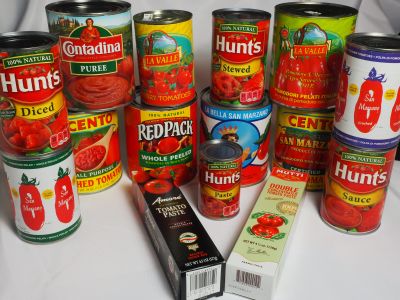
1. San Marzano Tomatoes >>
2. Whole Tomatoes >>
5. Stewed Tomatoes >>
6. Cherry Tomatoes >>
7. Tomato Paste >>
9. Tomato Sauce >>
1. San Marzano Tomatoes
If you have ever watched any of the famous Italian chefs on television and someone asks them what kind of tomatoes to use, the answer will always be San Marzano tomatoes. In Italy, certain foods are certified by a Consortium to come from a specific region and to be processed in accordance with certain laws and standards. Examples would be Parmigiano Reggiano cheese, Proscuitto di Parma ham and Pecorino Romano cheese. San Marzano tomatoes fall into this class.
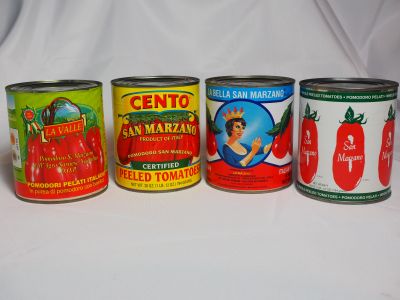
However, not every can of tomatoes you see in the store that has San Marzano on the label contains "Certified" San Marzano tomatoes. The Certified San Marzano tomatoes will have a D.O.P. reference on the label of the can which stands for Denominazione d' Origine Protetta. This means it has Domain of Origin Protection and that the tomatoes in that can have met certain standards, including:
- the plants are grown within the defined areas of Italy, most notably in the volcanic soil near Mt. Vesuvius
- the specific growing area meets certain environmental and soil conditions
- the tomatoes have been harvested from a particular type of tomato plant with specific characteristics
- the can must contain only whole tomatoes or strips of tomatoes
- the tomato itself meets certain standards, like color, density, etc.
- and so on... and unless you're a grower or importer, you probably don't need to know more.
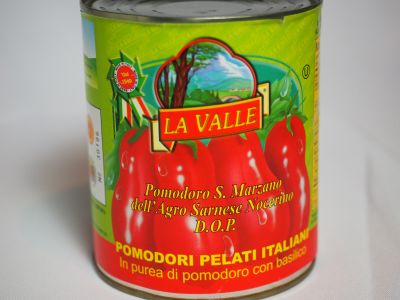
The can will also have two seals from the Cosorzio San Marzano and the D.O.P. and the D.O.P. will assign a serial number to the can that will be displayed in the same area on the can where the seals are located. They will typically cost from one to several dollars a can more but can be worth it for the right sauce. So now you should have enough information to be able to identify a can of Certified San Marzano tomatoes but that is not the only thing you should consider when looking for San Marzano tomatoes.
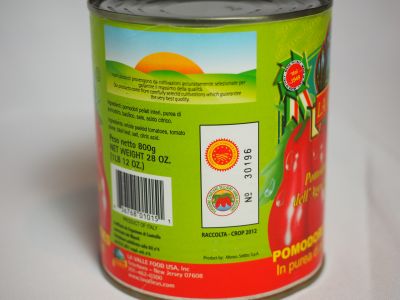
San Marzano is not only a region in Italy but also a variety of tomato plant. The San Marzano tomato is an heirloom variety of tomato (not a hybrid tomato seed) that is thinner and more elongated than the Roma or plum tomato. So even though the can of tomatoes may not be certified you may be getting the San Marzano variety of tomato. And it may even be a San Marzano tomato that was grown in one of the designated regions of Italy but the grower or cannery didn't want to go through the certification process.
So let's take a look at several varieties of canned San Marzano tomatoes that are not D.O.P. certified and look at what the labels tell us. In the picture below, starting with the left (9 o'clock postition) and going clockwise are:
- La Valle D.O.P. Certified San Marzano Tomato
- Hunts Whole Peeled Plum Tomato (not SM, for comparative purposes only)
- Cento San Marzano with the word "Certified" on the label
- San Marzano Brand Tomato
- La Bella San Marzano Tomato

Although we have already talked about the D.O.P.certified tomato it is worth noting the distinctive shape of this tomato. And the Hunt's tomato is in this picture just for comparative purposes only, it makes no claims of being a San Marzano tomato. Also, not every tomato in each can is shaped exactly the same either.
The number 3 tomato is a Cento "Certified" San Marzano tomato. When we look at the can we see phrases like Pomodoro San Marzano and Product of Italy and Certified. On the other side of the can we see a claim that these tomatoes are grown in the Sarnese Nocerino region of Italy and that these tomatoes have been certified by a third-party agency. So while this is not a genuine "Certified" tomato, it could very well be it's next door neighbor for a dollar a can less.
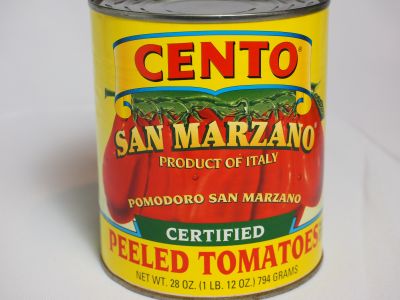
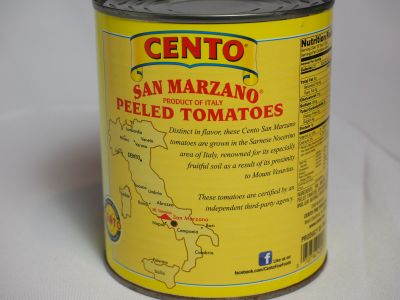
Number 4 is the San Marzano brand of tomato. When we read this label we clearly see these tomatoes are "Grown Domestically in the U.S.A." So since it does not look like a San Marzano tomato, I contacted the company and they said "Our tomatoes are grown in Ohio and Pennsylvania from a select Non GMO Hybrid seed." I know they grow some good tomatoes in PA so it's probably worth a try, but it is not from the San Marzano region nor is it a San Marzano type of tomato.
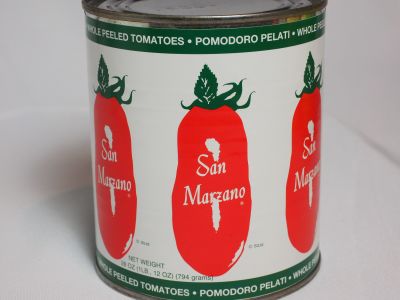
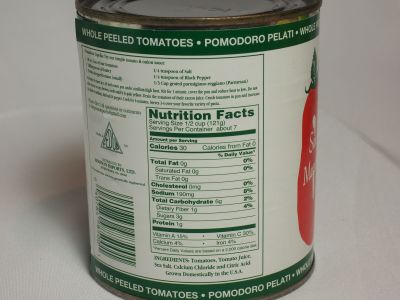
Number 5 is the La Bella San Marzano which is labeled as Italian Plum Peeled Tomatoes. Nowhere on the label other than the main heading does it indicate these are San Marzano tomatoes or that they are from any specific region in Italy. On the ingredient list it does say "Plum - Pomodori Pelati Italiani." So it is telling us these are Italian plum tomatoes, but not San Marzanos. It does have the elongated shape of the San Marzano but this is one we would need to try to see how close it is.
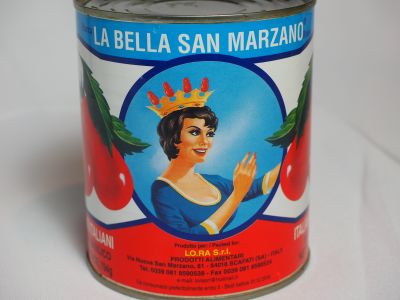
The most interesting thing about the picture of the 5 brands is that the two brands canned in the U.S. are clearly a different type of tomato than those imported from Italy. In addition, the US brands are both much firmer than their Italian counterparts, which tend to fall apart in your hands when you pick them up. So take this into account when selecting a whole canned tomato for your recipe. For a quickly cooked marinara the softer tomato would probably be better and for a longer cooking sauce you may use a mix or a US packaged tomato so you have some remnant pieces of tomato after the sauce cooks.
2. Whole Tomatoes
San Marzano tomatoes by definition fall into the category of whole tomatoes which are exactly what it says. Not broken or diced or squashed and if they are anything less than whole, do not buy them again.
Usually a plum or Roma type of tomato they tend to be very meaty tomatoes and are packed with the seeds and internal liquids, although seeds should be minimal. They are peeled and canned in either their juices or in a tomato puree. They are heated only for purposes of canning so they will be among the least cooked varieties of canned tomatoes and thereby tend to taste fresher and more lively. Also, since they are whole, packers tend to use the best tomatoes and the broken or blemished ones are used for the crushed or pulverized types.
When looking for whole tomatoes, it's worth taking a quick look to see what's in the can. I examined the ingredients list and the nutritional information of the four different cans of tomatoes pictured below. Citric acid is added to the vast majority of canned tomatoes for safety sake. Calcium chloride is added only to the brands processed in the US because evidently we in the US tend to like our tomatoes firmer than the Italians but that also makes it harder for them to break down in a sauce. Salt is added for flavor.
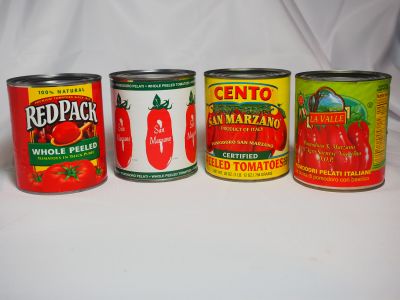
- the Redpack Tomatoes are a domestic product containing "Tomatoes, Tomato Puree, Salt, Calcium Chloride and Citric Acid" with a per serving sodium content of 180 mg per 1/2 cup serving
- the Cento San Marzano Tomatoes are an imported product containing "San Marzano Whole Peeled Tomatoes, San Marzano Puree, Basil Leaf, Naturally Derived Citric Acid" and have 20 mg of sodium per 1/2 cup serving
- the San Marzano brand of tomatoes, again a domestic product, contains "Tomatoes, Tomato Juice, Citric Acid, Calcium Chloride" and have a per serving sodium content of 10 mg per 1/2 cup serving
- the La Valle D.O.P. Certified San Marzano tomatoes contains "whole peeled tomatoes, tomato puree, basil leaf, salt, Citric Acid" and have a per serving sodium content of 20 mg per 1/2 cup serving
When using whole in a dish or a sauce, you can lightly or thoroughly crush them with your hands, you can run them through a tomato press to make more of a puree, you can run them through a food processor, an upright blender or an immersion blender to break them up as much as you want or you can just dump them in the pan and break them up with a spoon as they are cooking. This decision has to do with what you want the consistency of your sauce to be in your dish. I tend to like pieces of tomato in all my sauces but occasionally I will make a sauce that is more like a pizza sauce where it is more to the smooth side.
3. Crushed and Ground Tomatoes
I have included ground tomatoes and crushed tomatoes in the same group because you can't really distinguish the difference between them based solely on the label. Generally they are tomatoes that have been, as it says, crushed or ground so that what you have is a product with some level of puree along with some chunks of tomatoes, however small they might be. These are also a lightly cooked product so they should maintain a pretty true flavor. But that varies brand to brand.
They will add more body to a sauce than simply hand crushing whole tomatoes or even putting whole tomatoes in a blender because the water content of the whole tomatoes will be greater. If you look at the picture below, going from left to right are Pastene Brand Ground Tomatoes, Cento Brand Crushed Tomatoes and San Marzano Brand Crushed Tomatoes.
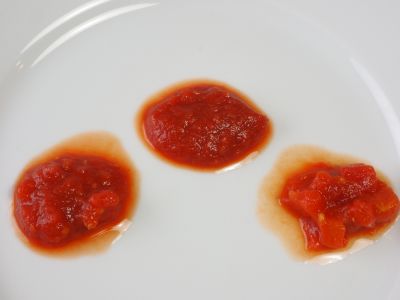
Several things jump out at you. First, there are more chunks of tomato in the Pastene Ground Tomatoes on the left than in the Cento Crushed Tomatoes in the center. And there are more chunks in the San Marzano Crushed Tomatoes than in the Pastene Ground Tomatoes. So as I said, you can't depend on the label. One crushed product has less chunks than the ground and one has more.
The second thing to notice is that the water seepage is greatest from the San Marzano Crushed and least from the Cento Crushed. This indicates the percentage of tomato vs. puree in the product. The puree will give off less water than the tomato chunks. So again, not saying one product is better than another, it depends what kind of sauce you are making and what you like. Crushed and ground tomatoes will almost always be used to make spaghetti (or tomato) sauce/gravy. They add a nice body to the sauce whether they are used alone or with one of the other tomato products.
4. Diced and Chopped Tomatoes
Diced or chopped tomatoes are again exactly what they say they are, tomatoes that have been cut up into consistently sized pieces and packed most typically in tomato juice. They tend to be a more watery product and as an example, the recipe on the back of a can of Hunts Diced Tomatoes calls for them to be used drained. A quick addition to a casserole or to drain them and have some usable chunks of tomato to top a simple bruschetta. And again, this is a lightly cooked product.
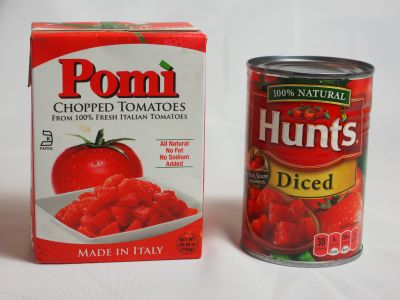
We also see an entry here from Pomi Tomatoes which is an Italian brand of tomatoes that comes packed in a box, not a can. They claim to be packaged in BPA free containers and have no preservatives, citric acid, artificial flavors, added water, or added concentrates. The ingredients list says Tomatoes, that's it.
In the picture below we have the Pomi Chopped Tomatoes on the left and the Hunts Diced Tomatoes on the right. As you can plainly see the chunks of the Hunt's tomatoes are firmer and more clearly defined which is what we saw in the whole tomatoes as well. This is due to the addition of the calcium chloride. The Pomi tomatoes look like they are a thicker product but notice the water leeching out of both is about the same.
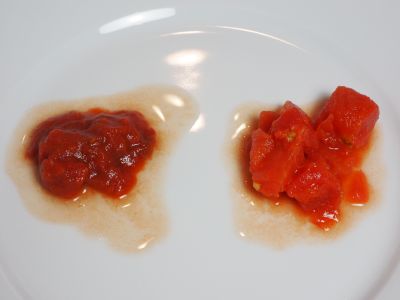
The Hunts product has 200 mg of sodium per 1/2 c serving while the Pomi has but 5 mg for the same serving size. It should be mentioned that Hunts does offer a a salt free version of the diced tomatoes as well that has only 15 mg of sodium per serving. From the American brands like Hunts, you can also get flavored tomatoes with all sorts of things like roasted garlic, oregano, basil, rosemary, etc. The Pomi on the other hand will add a little more body to your recipe and smaller pieces of tomato as well.
5. Stewed Tomatoes
A can of Stewed Tomatoes comprises chunks of tomatoes, tomato juice and sugar, cooked with citric acid, calcium chloride, salt, dried celery and green bell peppers, and some other flavorings. It has a sodium content of 300 mg per 1/2 c serving and is the only canned tomato product of which I am aware that adds sugar. It can be used in recipes with other ingredients, but I can't imagine making a sauce out of it. Some people heat it up and eat it as a side dish if that's what you like.
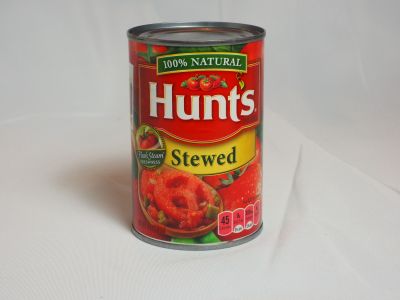
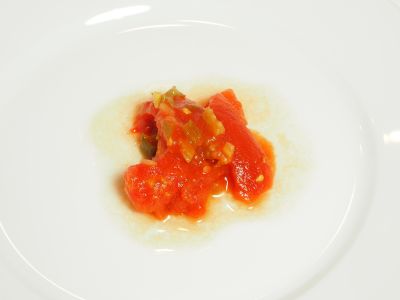
6. Cherry Tomatoes
Canned cherry tomatoes are exactly that, whole cherry tomatoes in a can. They are imported from Italy and I am not aware of any produced in the US but if there are please let us know. The ingredients listed on the can are small tomatoes and tomato juice, which is more of a tomato puree than what we would think of as tomato juice in the US.
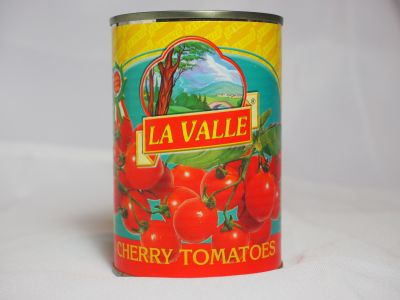
On a trip to the North End in Boston in search of canned tomatoes for this discussion, I ran across a can of cherry tomatoes and decided to add them to the collection. I have never used them for cooking but think they would make an interesting presentation in a marinara sauce that cooks quickly without a whole lot of stirring. I don't think this is the type of tomato you would want to cook for a longer period of time. If anyone has any experience with them please let us know.
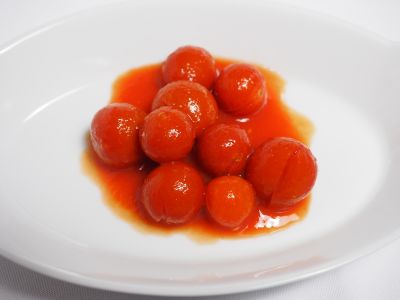
7. Tomato Paste
Paste is made by cooking tomatoes to remove the water content and then straining the resultant product to remove the skins and seeds. It is then cooked further to remove more of the water to create a very thick paste. It can be purchased in small cans or in squeezable tubes which is practical because it is usually used in small amounts to add body or color to sauces or other dishes.
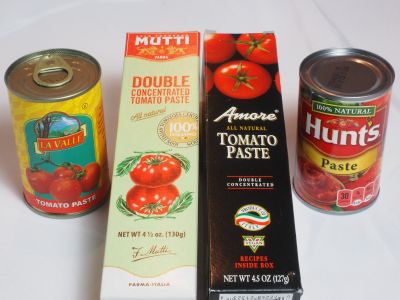
Tomato paste is quite often used as the base of pizza sauce by adding water and then whatever spices you want to flavor the sauce. Because of its initial thickness you can control the thickness of your sauce by how much water you add. For every 1 cup of paste you would typically add 1 1/2 to 2 cups of water. It is also the base of the canned tomato puree and tomato sauce products we will discuss below. In the following picture, we see the Amore paste from the tube and the Hunts from the can. Notice in both cases now thick the paste is. It maintains its form and there is no liquid seeping out around it at all.
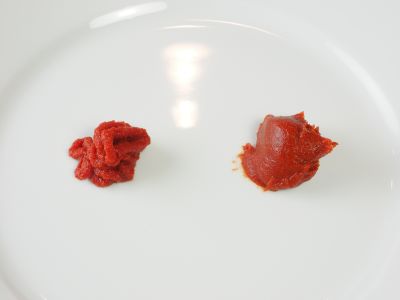
Tomato paste can also be used to add color and depth to recipes like stews where after browning meat and before adding liquid, add a couple of tablespoons of paste and cook for a bit and then add the liquid or vegetables. It can also be used for spaghetti sauce after sauteing onion and garlic by adding some to the pot and cooking it for a bit before adding the tomatoes. It does tend to be a bit acidic so you may want to add a few granules of sugar once you start tasting your sauce.
8. Tomato Puree and Strained Tomatoes
Tomato puree is basically tomato paste with water added to it. Looking a can of Hunts Tomato Puree the ingredients are "Tomato Puree (Water, Tomato Paste, Citric Acid)." So you can use it already mixed or mix your own. Again, this is a great thickener for a sauce if you find one you like.
Pomi makes one called strained tomatoes which is similar to the consistency of tomato puree but the only ingredients listed again are tomatoes. So even though it is the same consistency it is not reconstituted from paste. You can see pictures of both below, with the Pomi on the left in both pictures.
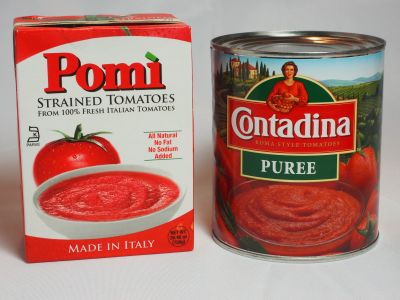
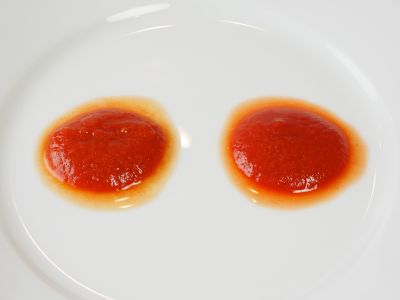
9. Tomato Sauce
Tomato sauce is somewhat thinner than puree as well it should be. Looking at the label on a can of Hunts tomato sauce, it reads "Tomato Puree (Water, Tomato Paste), Water, Less than 2% of Salt, Citric Acid, Spice, Tomato Fiber, Natural Flavor." So here we have tomato puree with water and spices added to the product. So we know this is a cooked product and the per serving level of sodium in this is 410 mg sodium per 1/4 cup of tomato sauce.
You can also buy a no-salt version of the Hunts sauce that takes the sodium level down to 20 mg per serving. And you can buy versions flavored with things like roasted garlic, basil and oregano. You could use it as a thickener for a sauce or in a recipe for another type of dish. Or you may want to think about making your own with a little tomato paste and water. In the picture below, you can see how it spreads out indicating a relatively thin tomato product.
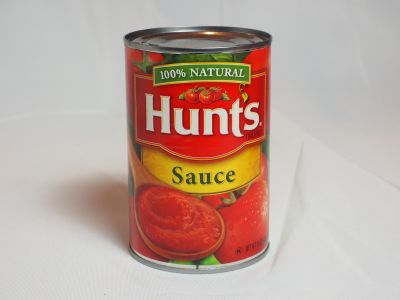
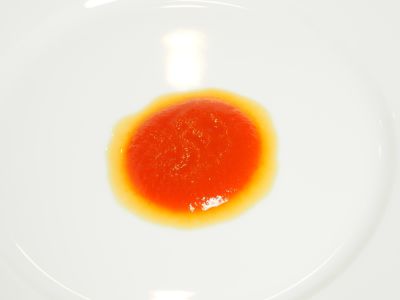
10. Why do they add citric acid to canned tomatoes?
Citric acid is added to the vast majority of canned tomatoes to elevate the acidity level of the tomatoes. According to information gleened from the University of Wisconsin web site on food safety, the tipping point for the growth of Clostridium botulinum, otherwise known as Botulism, is a pH value of 4.6.
Tomatoes straddle this number during the season, having a lower pH early in the season when they are green and acidic and a higher pH later in the season when they turn sweeter and are less acidic. At pH values below 4.6 (high acid foods) the botulism toxin will not grow so the foods can be treated at lower temperatures in a water bath whereas at values above 4.6 the food needs to be treated under pressure at a higher temperature which is not good for the tomatoes. Since the early 1990s, recommendations are to add citric acid either in a powdered form or as bottled lemon juice to assure the pH levels of the tomatoes stay safely below the 4.6 cutoff.
Regarding whether citric acid is good or bad for you, the website LiveStrong says:
"Citric acid is common in foods. It's both naturally occurring and a common additive that serves as a flavoring agent and preservative. Your cells also make citric acid. The citric acid you consume is neither good nor bad for you, and the citric acid you make is essential to life."
11. How do I reduce the acidity of tomatoes in my sauce
As we said before, tomatoes are naturally acidic and many people feel that this is not so much about reducing acidity, but balancing it. If you add sugar to a sauce, it does not reduce the acidity of the sauce, it balances against it and makes it seem less acidic and sweeter. Just add it slowly, a little goes a long way. You can also use carrots or onions in your sauce to add some sweetness to the sauce.
To truly reduce the acidity, I have read that you can add a small amount of baking soda to the sauce. I have never tried it because I never found the need to. If it is something you do, add a comment and let us know your experience with that. Again, add it slowly as in 1/4 t at a time and let it cook at least 15 minutes.
12. Why do they add calcium chloride to canned tomatoes?
Calcium chloride is used in tomatoes to keep the tomatoes firmer and less likely to break up during and after the canning process. It is an approved food additive and is generally considered harmless. If you buy a can of tomatoes imported from Italy without calcium chloride such as a San Marzano, and compare the texture of those tomatoes to a US grown product with calcium chloride, the Italian tomatoes will be much softer in feel and will break up much easier in a sauce.
The calcium chloride product will be much firmer and better shaped. That can be good or bad depending on what you are trying to accomplish. If you are making a marinara that is a killer because you don't want to be cooking a marinara sauce for a long period of time. If you want a sauce you are going to cook for several hours on the stove it will work great. So as with everything else, it comes down to what you like.
13. Why do they add salt and basil to canned tomatoes?
These items are added for flavor only and frankly, if you look at the sodium content in the cans with added salt, I think I would tend to go for the low sodium and add my own salt. But again, whatever you like. And I would discard the basil after opening the can and add your own fresh or dried basil to your sauce.
Summary
The conclusion to draw is to go ahead and try the different tomatoes and use what you like for the different types of recipes you are making. What you will find I suspect is that you will or already have develop favorites and your recipes will be developed around their flavor profile, consistency and appearance. Have fun and just remember, you can never make too much spaghetti sauce!
Share Your Opinion of this Recipe and How You "Make It Mine"
We're very glad you have chosen to share your thoughts. It's what we're all about. (All comments are moderated)
Please enter your name so people will know which comments are yours. You can use your real name or pick a user name if you prefer. To subscribe to our newsletter, enter your email address. And we never share any of your information with anyone, EVER! And if you submit a rating it must be accompanied by a comment and a name to be counted.
Get Our Newsletter!
Recent Comments
Meat Loaf
The meatloaf was moist, smooth and cooked perfectly through. The glaze was different but terrific...a nice change. Totally recommend and I give 5 s...
Eileen -- 5/17/18
I boil mine in the pressure cooker for 5 minutes, the easiest eggs to peel
Kori -- 4/10/18


